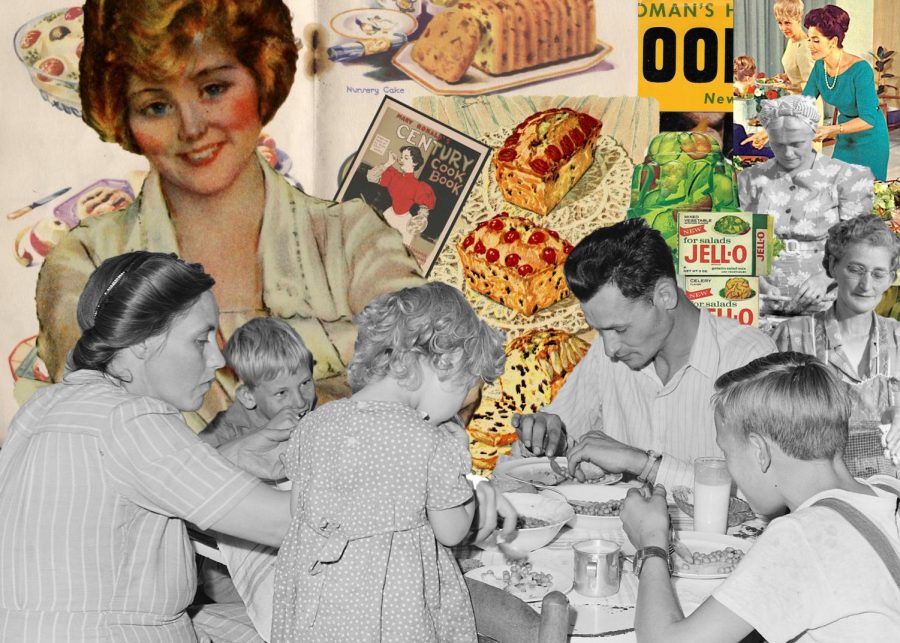The Direction of Dinner: As family dynamics change, shared dinnertime doesn’t disappear. It evolves.
November 19, 2019
It’s dinnertime in 1950, and your mom has just set the dinner that she painstakingly cooked on the table. Your father sits at the head of the table, mom opposite him and you and your siblings in between them. A small conversation about your father’s day at work takes place as you smile and eat your food; the perfect 50s family dinner. But it’s no longer 1950 and so much has changed, especially the family dinner.
A study by New York University Langone Health found that, in the past 20 years, the frequency of family dinners has declined by 33 percent. This decrease in family mealtime has been caused by drastic socio-economic change.
Now, more than ever, women, wives and mothers are encouraged to have a career that they are passionate about. The stay-at-home mom is becoming less common. This means that parents, and even older children, may have conflicting schedules that make it difficult to gather everyone together in the evenings for a meal. These shifts in family dynamics, including the ever-evolving definition of “family,” have required an evolution in what constitutes as family dinner.
Sophomore Jocelyn Garcia knows first-hand the impact that family dinners has on a young person’s life, and how difficult it is to make happen. “Usually me and my older sister get home like an hour before everyone else, so we just take a shower and do some things before [my family] get[s] home. When they get home, we all eat together,” Garcia said.
Garcia and her family have found that family dinners are an important part of their lives, and have chosen to do what they can to ensure most dinners are enjoyed together.
Family has had a large impact on how people incorporate dinner into their life. Since the 1950s, the amount of “nuclear families,” a couple with children all in one household, has dropped significantly. According to a study conducted by the Pew Research Center in 1960, 73 percent of households were nuclear families, compared to 46 percent in 2014. While it is still the most common family-type in the U.S., there is more diversity than ever when it comes to the concept of family. Couples with no children, LGBTQ+ families and single-parent homes have increased since the ‘50s.
Along with a large change in the type of families between generations, there is also a gap in ideas of how dinner should be eaten.
“[When I go] to my grandma’s [house, my grandparents] always eat at the dinner table; breakfast, lunch and dinner. If they go get food, they [still] bring it back and eat it at the table,” Story Presnell (11) said.
Normally, Presnell’s parents get home later so he eats in his room, and when his parents get home they usually eat in the living room while watching TV. This is becoming more and more of a trend throughout society. The need for a dining room as a place just for dinner is decreasing.
Some families feel that the change of direction for family dinners isn’t a bad thing as they’ve experienced that there are better ways to spend quality time with their children. Many parents feel like there aren’t very many groundbreaking conversations that can happen over the dinner table during the average 15-30 minutes dinner actually lasts, especially because most of the focus is placed on actually eating.
Other distractions like phones, TV and work make it difficult for family members to really be present while eating. Because of this, parents like Rochuan Meadows-Fernandez, author of an article titled “Why We Don’t Do Family Dinners,” try to incorporate quality family time into their lives in other newfound ways. Meadows-Fernandez writes that this can be accomplished by playing family games together, watching shows and trying to have conversations during car rides.
Another parent from Meadows-Fernandez’s article said that car rides were where her teens chose to open up the most. New ideas of how you can incorporate quality family time and conversation are surfacing everyday and might make the need of a family dinner less important for some people.
Discovering how dinner works for each person or family can pose some challenges. Many people in their 20s through 30s are focused on their career and trying to find a sustainable way of life. This can leave people feeling very busy and overwhelmed. In a video posted to YouTube titled, “I Only Ate Chrissy Teigen’s Recipes For A Week,” Lindsay Webster talks about her dinner routine, how hard it was to find the time for cooking dinner within her busy schedule and how postmates and meal delivery have become her normal. A lot of young people entering the workforce face similar issues with feeling as though there is simply no time for cooking dinner every day.
The traditional and true family dinner may never lose its importance in specific cultures, but we can expect that as we continue to advance technologically and society, the way that people choose to eat dinner will continue to evolve for the better. More acceptance towards people and culture can bring about new customs and ideas pertaining to what dinner means for everyone and what makes it work in its own, unique way.










